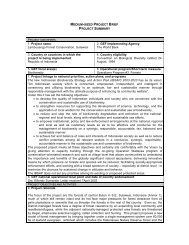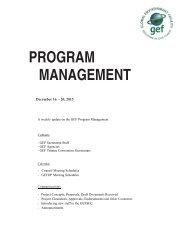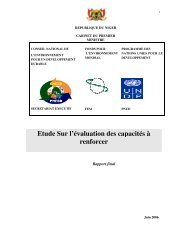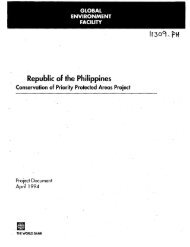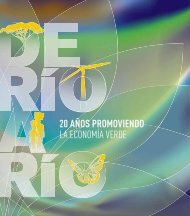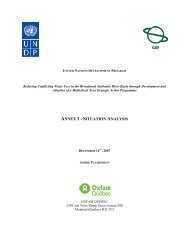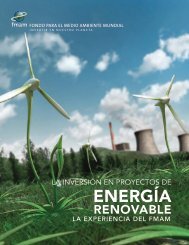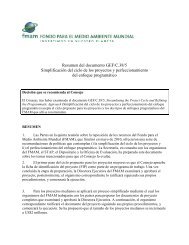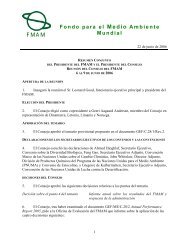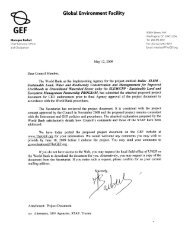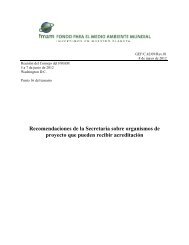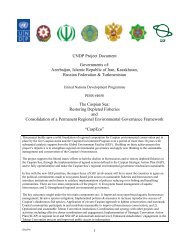English - Global Environment Facility
English - Global Environment Facility
English - Global Environment Facility
You also want an ePaper? Increase the reach of your titles
YUMPU automatically turns print PDFs into web optimized ePapers that Google loves.
technical assistance includes dissemination of innovative technologies for ecotourism promotion<br />
in target markets, .enhancing energy-efficiency in tourism services, visitor safety, and private<br />
sector and community participation in biodiversity monitoring; (ii) capacity building of existing<br />
local networks of service providers and development of ecotourism business opportunities. In the<br />
case of the PAs where indigenous communities are present (e.g., La Amistad, Chagres, Darien),<br />
capacity building will be preceded by a socio-cultural process of familiarization or<br />
„rapprochement‟ with the communities to assess their interest in providing ecotourism services<br />
that are compatible with the principles of development with identity, their needs, expectations<br />
and concerns; (iii) elaboration of a minimum of 5 individual PAs business plans linking each PA<br />
to potential services providers, and the articulation of those plans within a broader strategic<br />
sustainable financing plan for all selected 9 PAs; (iv) development and implementation of<br />
environmental education campaigns aimed at key local and national stakeholders (public and<br />
private) and focusing on the economic value of PAs and the benefits of their sound management<br />
and use; (v) support to ATP and ANAM to undertake market studies, promotion strategies, and<br />
marketing campaigns to position the 9 pilot PAs and their service networks in the national and<br />
international ecotourism markets, including tools, participation in trade shows, printed and<br />
audiovisual material etc; (vi) issuing at least 4 concessions, 4 operating permits and 4 comanagement<br />
agreements under a streamlined and cost-efficient system, and; (vii) consolidation<br />
of at least 2 productive value chains connecting tourists, national tour operators and local service<br />
providers for two PAs with the greatest competitive advantage to ensure that communities and<br />
small businesses have better access to markets.<br />
EXPECTED GLOBAL ENVIRONMENTAL BENEFITS TO BE DELIVERED<br />
18. The project contributes to advance the Programme of Work on Protected Areas of the CBD (in<br />
particular the goals of program elements 1, 2 and 4), the Plan of Implementation of the World<br />
Summit on Sustainable Development (in particular section IV), the World Ecotourism Summit<br />
2002 and its Quebec Declaration, and the <strong>Global</strong> Code of Ethics for Tourism as adopted by the<br />
UN World Tourism Organization, in order to increase the benefits from tourism resources for<br />
local communities while mainstreaming the cultural and environmental integrity of those<br />
communities and enhancing the protection of ecologically sensitive areas and natural heritage.<br />
19. This project contributes to the generation of global environmental benefits through:<br />
a. Improved overall management effectiveness and financial sustainability of a network of<br />
protected areas totalling an extension of 1,264,534 ha of terrestrial PAs (42.2% of the<br />
national system‟s total) and 213,253 ha of protected marine PAs (49.3% of the national<br />
system‟s total), including three areas of international recognition (Darien National Park and<br />
International Park “La Amistad”, which are declared Biosphere Reserves and UNESCO<br />
World Heritage Sites, while the Coiba Marine National Park is a UNESCO World Heritage<br />
Site). All nine PAs selected as priorities are also classified as Important Bird Areas (IBA) of<br />
Panama for their global relevance in providing habitat for the conservation of bird<br />
populations, including globally threatened and restricted range species.<br />
b. Contribution to the protection of habitats for globally threatened species, including several<br />
endangered or vulnerable (as defined by the IUCN Red List) frogs (e.g., Atelopus certus, A.<br />
glyphus, A. zeteki), marines turtles (e.g., Eretmochelys imbricata, Demochelys coriacea),<br />
birds (e.g., Ara ambigua) and mammals (e.g., Tapirus bairdii). Moreover, the network of<br />
nine pilot PAs presents a high level of biodiversity and endemism, such as is the case with<br />
CEO Endorsement Template-December-08.doc 16



